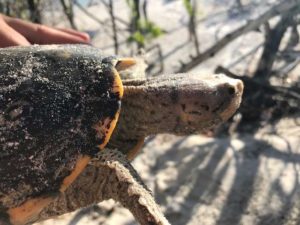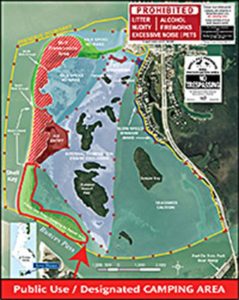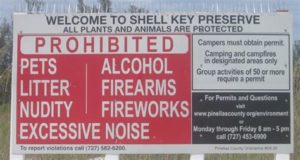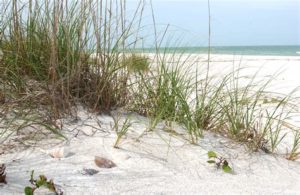
If you’ve never seen Shell Key, it’s hard to believe that this piece of paradise still exists in the state’s most densely populated county. The 1800-acre preserve features one of the county’s largest undeveloped islands, as well as numerous mangrove islands and expansive seagrass beds. Ecological protection within the preserve is critical to support the biologically diverse species associated with Shell Key including wintering and nesting birds, fish, nesting sea turtles, diamondback terrapins, manatees, and other plants and wildlife.
Shell Key also is a popular destination for boating, camping, fishing and just relaxing. With proper management, recreation can be compatible with the protection of the natural resources.
 Owned jointly by the state, county and private entities, Shell Key is managed as a preserve by Pinellas County. Regular management plans are required for approval by both the board of county commissioners and the Florida Department of Environmental Protection. At first glance, little has changed from the 2007 plan directing priorities and activities on the barrier spit accessible only by boat.
Owned jointly by the state, county and private entities, Shell Key is managed as a preserve by Pinellas County. Regular management plans are required for approval by both the board of county commissioners and the Florida Department of Environmental Protection. At first glance, little has changed from the 2007 plan directing priorities and activities on the barrier spit accessible only by boat.
“We are proposing a fee-based permit for camping through a PCR (Parks and Conservation Resources) administration registration program. This system may give us the flexibility to adjusted the number of permits issued seasonally to reduce human disturbances to nesting shorebirds and sea turtles,” said Pam Leasure, Pinellas County’s environmental lands manager for south Pinellas.
That small change is a good first step toward balancing competing uses on a tiny spit of land that can attract hundreds of boaters on a pretty summer weekend, said Maya Burke, science policy coordinator for the Tampa Bay Estuary Program and a member of the Shell Key Advisory Committee. “There are regulations that ban beer or pets on the island, and signs telling people not to enter the bird sanctuary.”
 Enforcement of regulations is under the auspices of FWC (Florida Fish and Wildlife Conservation) and the Pinellas County Sheriff’s office, each of whom have large regions to patrol.
Enforcement of regulations is under the auspices of FWC (Florida Fish and Wildlife Conservation) and the Pinellas County Sheriff’s office, each of whom have large regions to patrol.
The meeting also will include a much-anticipated presentation by University of South Florida Professor Ping Wang who specializes in coastal systems. At the request of the Shell Key Advisory Committee and public commenters, the county held off on finalizing the management plan until the results of Dr. Wang’s study were available.
Like all natural barrier islands, Shell Key moves over time. In fact, it didn’t exist until about 30 years ago, except as a sandbar. For decades, tidal flow entered the preserve separating Shell Key from Terra Verde both from the south at Bunces Pass and the north at the Shell Key Pass. But over time, Shell Key pass silted up, blocking tidal flow from the north – until Hurricane Irma opened a new pass last summer.
 Wang, who has worked with the Florida Department of Environmental Protection on projects both north and south of Shell Key, believes that the pass closing was part of the natural process that originally created Shell Key.
Wang, who has worked with the Florida Department of Environmental Protection on projects both north and south of Shell Key, believes that the pass closing was part of the natural process that originally created Shell Key.
He also points out that Bunces Pass in the south is much larger and open to tidal flow than the northern pass.
Environmental monitoring data shows that water in the preserve has not suffered. “Water quality is consistently good and seagrasses continue to expand and thrive,” Burke said.
There’s also some controversy about exactly where the sand that filled in the north pass is coming from. Some Tierra Verde residents worry that it is coming from beach renourishment projects north of Shell Key.
However, as part of the study, Wang developed a detailed sediment budget and concluded that very little nourishment sand has made it to Shell Key.
For more information, or to be part of the discussion, a formal meeting is scheduled for Wednesday, August 15, 2018, at Tampa Bay Watch, 3000 Pinellas Bayway South, Tierra Verde, FL 33715, from 6:30 to 8:30 p.m.
Check out our online map to see how Shell Key has changed over the past 80 years!
